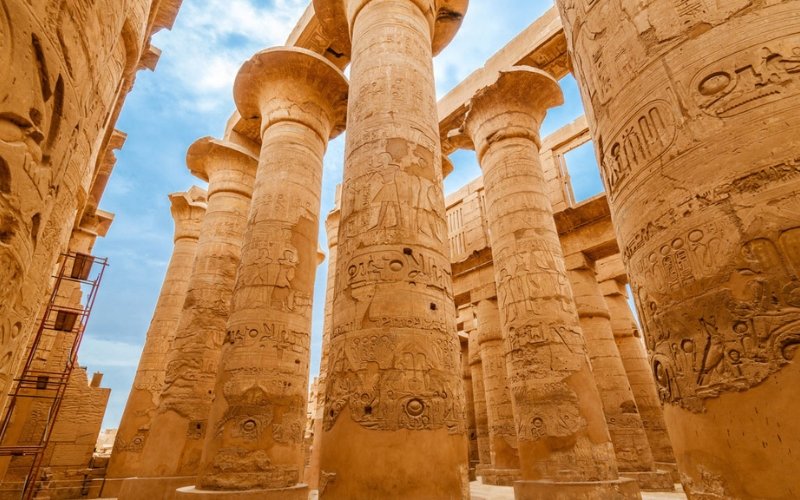The Temples in Egypt stand as grand testaments to a civilization that flourished along the Nile for millennia. These monumental structures are more than just stone and sand—they are sacred vessels of history, religion, art, and culture. Every pillar, carving, and hieroglyph narrates tales of gods, pharaohs, rituals, and societal life in one of the most iconic civilizations of the ancient world. The Ancient temples of Egypt serve as a bridge between past and present, drawing millions of tourists and scholars alike, fascinated by their grandeur and the mystique of their origins.
Key Takeaways
- The Temples in Egypt reflect the deep religious beliefs and architectural mastery of the ancient Egyptians.
- Egyptian temple architecture evolved over time, showcasing artistic and engineering innovations.
- The Most famous Egyptian temples like Karnak, Luxor, and Abu Simbel are UNESCO World Heritage Sites.
- Visiting the Top temples to visit in Egypt offers insight into ancient rituals, deities, and pharaonic power.
- Many Pharaonic temples in Egypt remain remarkably preserved, providing a direct link to ancient times.
1. Karnak Temple (Luxor)
Karnak Temple is one of the largest and most impressive religious complexes in the world, located in Luxor, Egypt. Dedicated primarily to the god Amun-Ra, along with Mut and Khonsu, Karnak served as a vital spiritual and political center for over 2,000 years.
Its construction spanned the reigns of numerous pharaohs, each contributing to its grandeur and scale. The Hypostyle Hall, one of the temple’s most iconic features, contains 134 towering columns arranged in 16 rows, with some reaching 70 feet high. These columns are intricately carved with hieroglyphs and scenes of pharaohs paying homage to the gods. Karnak also features an enormous Sacred Lake used for purification rituals and multiple massive obelisks, including those of Queen Hatshepsut and Thutmose I. The temple complex was connected to Luxor Temple by the Avenue of Sphinxes, used in grand religious processions. Karnak wasn’t just a place of worship; it was a city of priests, scribes, and workers that embodied the religious life of Thebes. The temple’s scale and continued expansion over centuries reflect its immense importance in ancient Egyptian culture. Visiting Karnak today offers a glimpse into the spiritual and architectural mastery of one of history’s greatest civilizations.
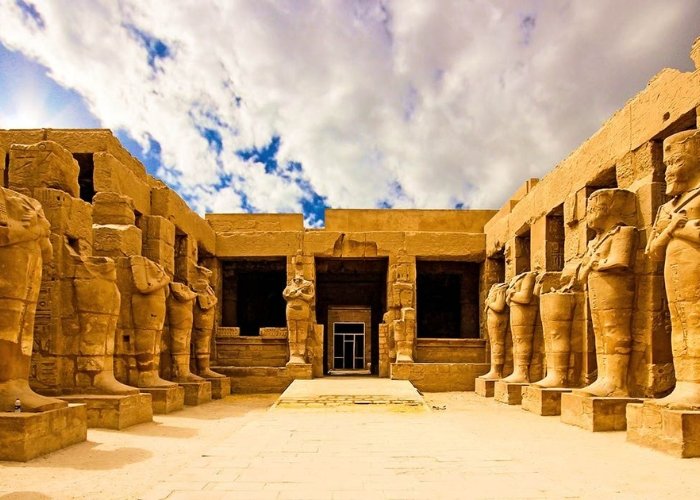
2. Luxor Temple (Luxor)
Luxor Temple, located on the east bank of the Nile River in Luxor, is one of Egypt’s most iconic monuments. Unlike many other temples dedicated to specific gods, Luxor Temple was primarily devoted to the concept of divine kingship and the rejuvenation of pharaohs, particularly in relation to the god Amun. Built mainly by Amenhotep III and later expanded by Ramses II, the temple features colossal statues of Ramses II that guard the entrance. A striking obelisk once stood in front—today, only one remains; its twin now resides in Paris. Luxor Temple was connected to Karnak Temple by the Avenue of Sphinxes, a ceremonial road used during the annual Opet Festival, when statues of the gods were paraded between the temples. The structure includes a large peristyle court, grand columns, and beautifully carved reliefs. In later periods, the temple saw additions by the Romans and even hosted a mosque, which still exists today. At night, Luxor Temple is dramatically illuminated, highlighting its magnificent architecture and stone carvings. Visiting Luxor Temple offers not only a look at pharaonic grandeur but also a layered history that reflects the changing spiritual and political tides of ancient Egypt.
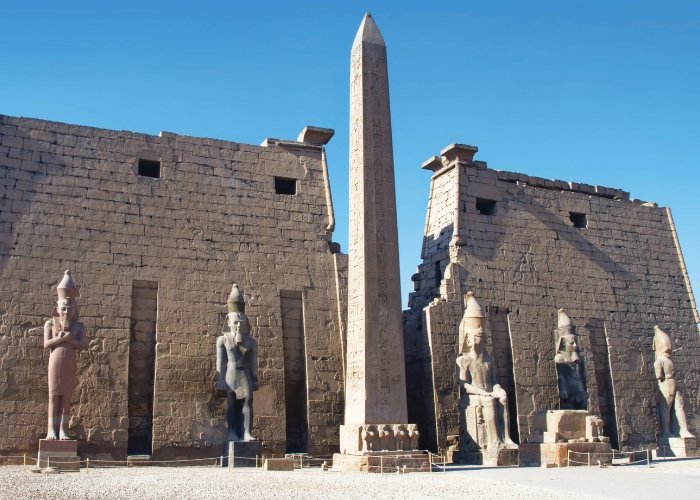
3. Abu Simbel Temples (Aswan)
The Abu Simbel Temples, located near the southern border of Egypt, are a stunning pair of rock-cut temples built by Pharaoh Ramses II during the 13th century BCE. Carved directly into a sandstone cliff, these temples honor the gods and Ramses himself, showcasing his political might and divine status. The Great Temple is famous for its four colossal statues of Ramses II seated at the entrance, each standing about 66 feet tall. Inside, elaborate reliefs depict the pharaoh’s military victories, notably the Battle of Kadesh. The smaller temple nearby was dedicated to Queen Nefertari, Ramses’ beloved wife, and the goddess Hathor—unusual in Egyptian history, as it gave the queen equal prominence to the king. In the 1960s, the entire complex was relocated to higher ground on artificial hills to avoid submersion caused by the creation of Lake Nasser, a result of the Aswan High Dam project. This monumental relocation effort, led by UNESCO, preserved Abu Simbel as one of Egypt’s most breathtaking and historically rich sites. Twice a year, sunlight illuminates the inner sanctuary, aligning perfectly with the statues—a testament to ancient Egypt’s architectural and astronomical genius.
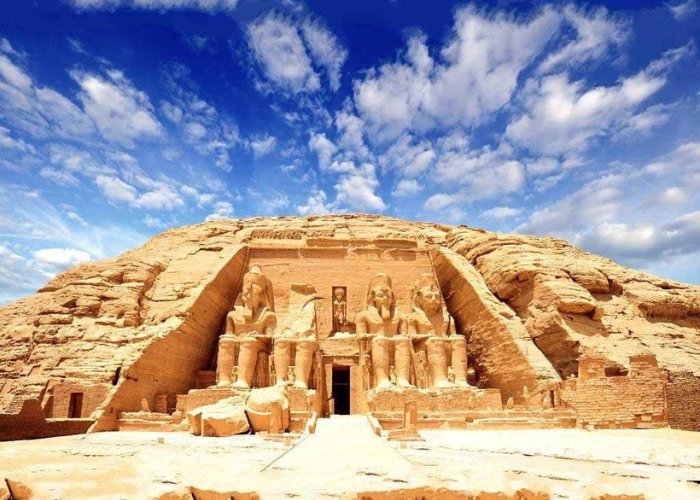
4. Temple of Hatshepsut (Deir el-Bahari)
The Temple of Hatshepsut, located at Deir el-Bahari on the west bank of the Nile near Luxor, is one of Egypt’s most architecturally unique and visually striking temples. Built for Queen Hatshepsut, one of the few female pharaohs of ancient Egypt, the temple served as a mortuary complex and a testament to her reign. Designed by her architect Senenmut, the temple is nestled against a dramatic cliff face and features three terraces connected by long ramps. Its layout blends harmoniously with the surrounding natural landscape, reflecting both aesthetic sensibility and symbolic power. The temple was dedicated to the god Amun, as well as to Hatshepsut’s divine birth and her expedition to the Land of Punt, which is depicted in detailed reliefs. These scenes highlight trade and diplomacy during her prosperous reign. Statues of Hatshepsut often portray her as a male pharaoh to reinforce her legitimacy. The temple’s elegance and innovation stand out among Egypt’s mortuary temples. Although some parts were damaged or defaced after her death, it remains a powerful symbol of Hatshepsut’s ambition, religious devotion, and architectural legacy. Visitors today admire its symmetry, artistic carvings, and commanding position amid the cliffs.
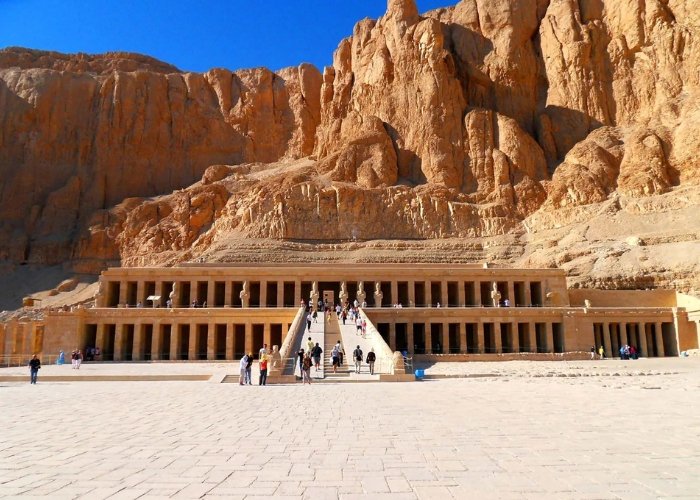
5. Temple of Philae (Aswan)
The Temple of Philae, dedicated to the goddess Isis, is one of the most enchanting temples in Egypt, known for its beautiful carvings and serene island setting. Originally located on Philae Island, the temple was relocated to nearby Agilkia Island in the 1960s due to the construction of the Aswan High Dam and the resulting formation of Lake Nasser. The relocation project was a massive international effort led by UNESCO to preserve this treasured monument. The temple complex features elegant colonnades, pylons, and reliefs that celebrate the myths of Isis, Osiris, and Horus. Pilgrims in ancient times considered Philae a sacred site, and the temple remained an active center of worship even into the Greco-Roman period, with Roman emperors adding chapels and inscriptions. The artistry of the temple is exquisite, with detailed depictions of the goddess Isis nursing Horus, and scenes of Pharaohs making offerings to the gods. As one of the last places where ancient Egyptian religion was practiced, Philae is both a historical and spiritual landmark. Today, its picturesque setting and preserved beauty make it a favorite among travelers seeking a mix of myth, history, and tranquil scenery.
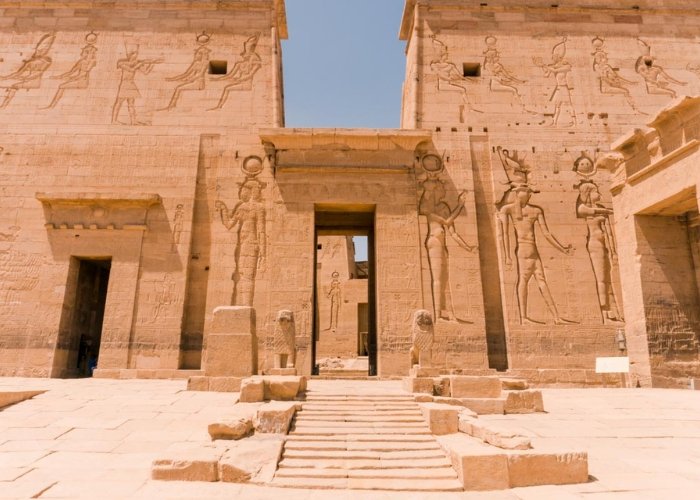
6. Temple of Edfu
The Temple of Edfu, located on the west bank of the Nile between Luxor and Aswan, is one of the best-preserved ancient temples in Egypt. Dedicated to Horus, the falcon-headed god, the temple was built during the Ptolemaic period between 237 and 57 BCE. Despite being relatively “young” compared to other Egyptian temples, its preservation provides invaluable insight into ancient temple architecture and rituals. The temple was constructed over the site of an earlier, smaller structure and followed traditional Egyptian design with pylons, courtyards, hypostyle halls, and sanctuaries. Towering walls protect the complex, and richly detailed reliefs narrate the mythical battle between Horus and his uncle Seth, who murdered Horus’s father, Osiris. The inner sanctuary once held a gilded statue of Horus and a ceremonial boat used in processions. Pilgrims came from across Egypt to honor Horus, and inscriptions throughout the temple reveal ceremonial practices and religious doctrine. Rediscovered in the 19th century under layers of sand and mud, the Temple of Edfu stands today as a nearly intact example of Egypt’s spiritual life during the Ptolemaic era. Visitors are often struck by its scale, symmetry, and the clarity of its reliefs and inscriptions.
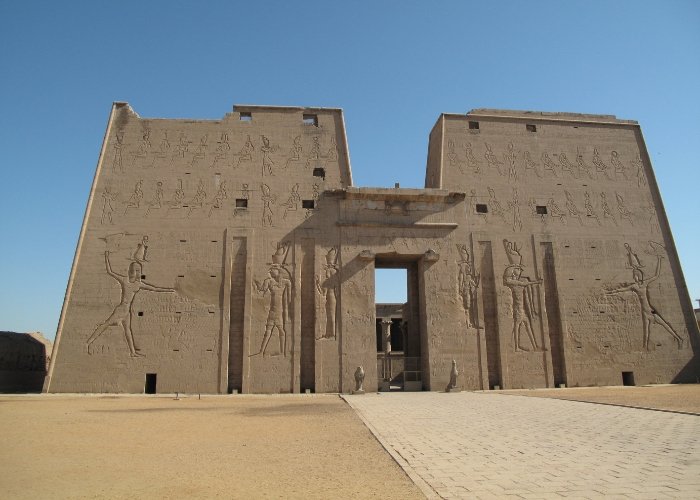
7. Temple of Kom Ombo
The Temple of Kom Ombo, located on a picturesque bend of the Nile north of Aswan, is one of Egypt’s most unique ancient structures due to its dual dedication. This symmetrical temple honors two gods simultaneously: Sobek, the crocodile god associated with fertility and the Nile, and Horus the Elder, the falcon-headed god of protection. The temple features twin entrances, halls, and sanctuaries—each side mirroring the other in devotion to its respective deity. Built mainly during the Ptolemaic period and later enhanced by the Romans, Kom Ombo reflects a fusion of Egyptian and Greco-Roman styles. One of its most intriguing highlights is a series of carvings showing ancient surgical instruments, offering insight into medical knowledge of the time. Nearby, a Crocodile Museum houses mummified crocodiles found in the region, underscoring the sacred role these creatures played. Though partially damaged by natural erosion and Nile floods, the temple’s unique structure, scenic location, and rare iconography make it a standout among Egypt’s temples. Visitors walking through Kom Ombo today experience a sense of duality—between gods, beliefs, and architectural forms—that reflects the complex spiritual life of ancient Egyptians under the Ptolemies.
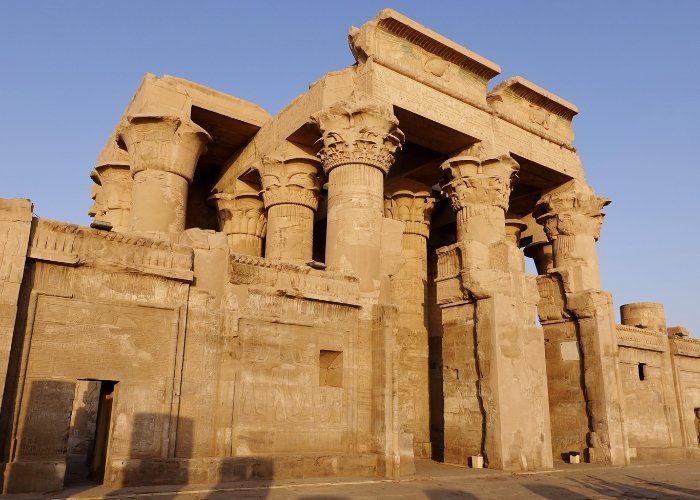
8. Dendera Temple Complex
The Dendera Temple Complex, located near the modern town of Qena, is home to one of the most remarkably preserved and richly decorated temples in Egypt: the Temple of Hathor. Hathor, the goddess of love, music, beauty, and motherhood, was revered here, and the temple reflects her joyful and nurturing qualities. Constructed during the late Ptolemaic period and completed under Roman rule, the main temple features grand stone columns topped with Hathor-faced capitals and vibrant astronomical ceiling reliefs. One of the most famous elements is the “Dendera Zodiac,” a celestial map found on the ceiling of a chapel, which shows constellations and planetary alignments, blending Egyptian and Greco-Roman astronomical knowledge. The temple also contains underground crypts with mysterious carvings and rooftop chapels that were used in rituals associated with the goddess’s appearance. The walls are adorned with colorful depictions of offerings, divine births, and ceremonial processions. Despite centuries of sand burial, the complex remains well-preserved, giving visitors a vivid view into the religious and cosmic beliefs of ancient Egyptians. Dendera’s blend of mysticism, architecture, and science makes it a fascinating stop on any tour of Egypt’s sacred landmarks.
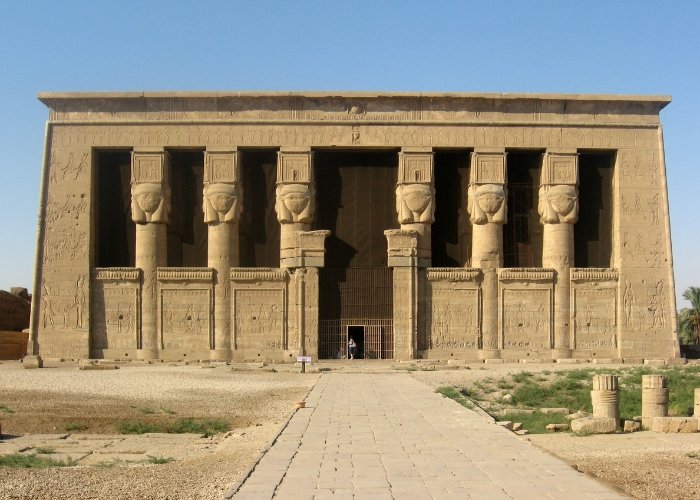
9. Temple of Seti I (Abydos)
The Temple of Seti I, located in Abydos, is one of ancient Egypt’s most spiritually significant temples. Dedicated to Osiris, the god of the afterlife, the temple served as a major pilgrimage site for Egyptians seeking connection with the divine and the afterworld. Built by Pharaoh Seti I and completed by his son Ramses II, the temple is known for its elegant architecture and deeply carved reliefs that are considered among the finest in Egypt. One of the most historically important features of the temple is the Abydos King List, a chronological list of 76 past pharaohs inscribed on a wall, offering critical insight into Egypt’s dynastic history. The temple is designed in a distinctive L-shape and features multiple sanctuaries for major gods such as Osiris, Isis, Horus, and Ptah. Abydos was believed to be the burial place of Osiris, making this temple a gateway to the divine and the eternal. Its well-preserved scenes depict religious rituals, offerings, and divine interactions in extraordinary detail. For scholars and spiritual seekers alike, the Temple of Seti I represents a convergence of history, devotion, and artistic excellence within one of Egypt’s holiest ancient sites.
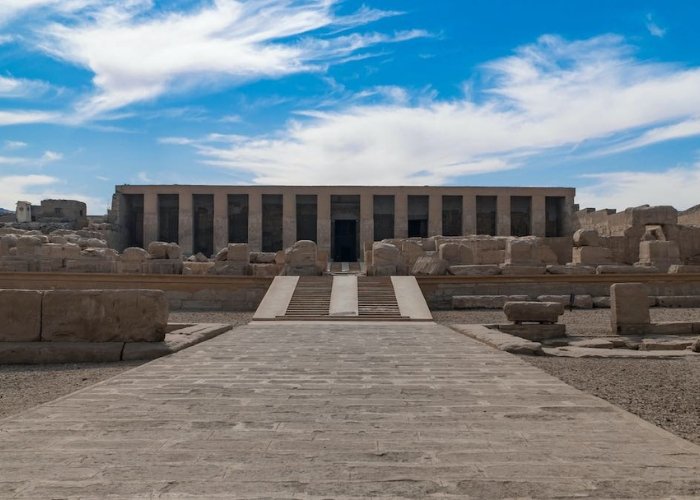
Conclusion
The legacy of the Temples in Egypt transcends stone and time. They are eternal echoes of a society that revered gods, celebrated cosmic order, and immortalized its rulers through architecture. Whether as pilgrimage centers, astronomical observatories, or masterpieces of engineering, these Sacred temples of ancient Egypt continue to captivate and inspire.
As you walk through their halls, touch their walls, and gaze at their hieroglyphs, you engage in a silent dialogue with the past. The Ancient Egyptian temples remain among the most profound and enduring legacies of human civilization—a testament to what humanity can achieve when driven by faith, power, and artistry


